Today we have the Supermicro SYS-5028D-TN4T on our review docket. The system came to us as a barebones system, and is ideal for office use. A system of this size would generally be limited to a processor with the equivalent of four Core i7 cores and 32GB of RAM, however with the new Intel Xeon D-1540 generation we get 8 cores, 16 threads, 128GB of RAM all in a small package. As one can see below, aside from our office testing, we also have this server running longer term in one of our colocation racks which it is handling very well. This is a very impressive system.
Test Configuration
With the onboard Intel Xeon D-1540 the only thing we needed to add was RAM and storage. Total assembly time was under 10 minutes and even a novice would be hard pressed to take longer than 15 minutes.
- Barebones system: Supermicro SYS-5028D-TN4T with onboard Intel Xeon D-1540 CPU
- Memory: 128GB (4x 32GB) Samsung ECC DDR4 Registered DIMMs
- Storage: 2x Intel DC S3700 100GB, 2x Intel DC S3500 800GB, 2x Western Digital Red 4TB
, Samsung XP941 512GB m.2 SSD
- OS: Ubuntu 14.04.2 Server
The goal of the configuration was to provide an excellent Docker and Linux virtualization platform for development. This is certainly a server you can keep desk-side.
Supermicro SYS-5028D-TN4T Overview
The Supermicro SYS-5028D-TN4T is very compact, measuring 9.45″ x 8.27″ x 11″ (HxWxD). For those that have used a typical mid-tower desktop chassis, this feels about half the size. Inside though is one heck of a system. The system is comprised of two primary components: a Supermicro X10SDV-TLN4F motherboard with an embedded Intel Xeon D-1540 SoC and a CSE-721TQ-250B chassis with an included 250w 80 Plus Bronze power supply.
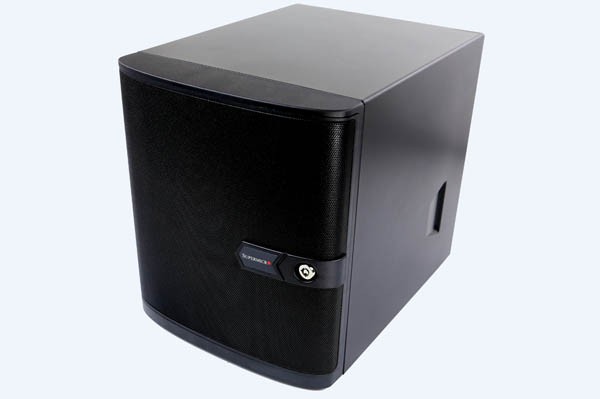
The front of the chassis has a door that can be locked to prevent unintentional tampering. This is a key differentiation point compared to using a standard consumer chassis. Behind the door there are four hot-swap bays along with the power button.
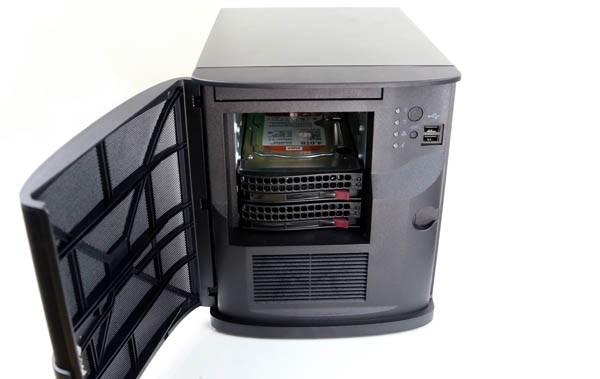
One can see that these four hot swap bays take 3.5″ drives. In the case of this barebones they are wired standard for SATA drives however one, in theory could use a HBA or RAID card and a breakout cable to use the chassis in single port SAS mode.

Beyond these four hot swap drives, one can use the top of the chassis either for a slim optical disk drive or for a 2.5″ drive.
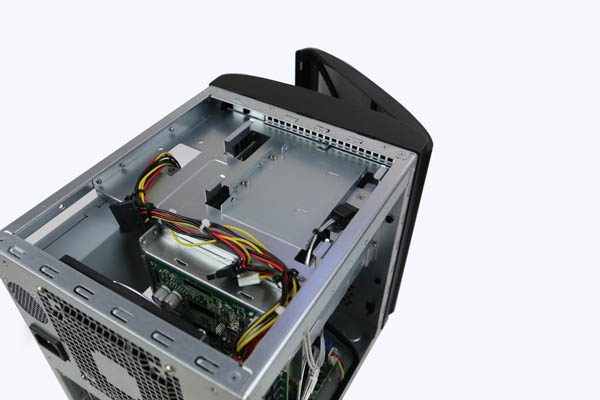
There is another 2.5″ drive holder on the side of the chassis. Our review sample did not come with power/ data cables for using both 2.5″ internal mounting points so we simply added our own at a cost of about $8 for the cables and 90 seconds of installation. That allowed for an internal RAID 1 mirrored SSD setup and use of all six SATA ports onboard without the use of a SATADOM.

The motherboard sits at the bottom of the chassis. It is cooled by a relatively diminutive active cooler and a large exhaust fan in the rear. When shrouded by the chassis, these coolers are relatively quiet, a situation enabled by the low power 14nm SoC onboard. You can see our Supermicro X10SDV-TLN4F review as it is a highly rated motherboard.
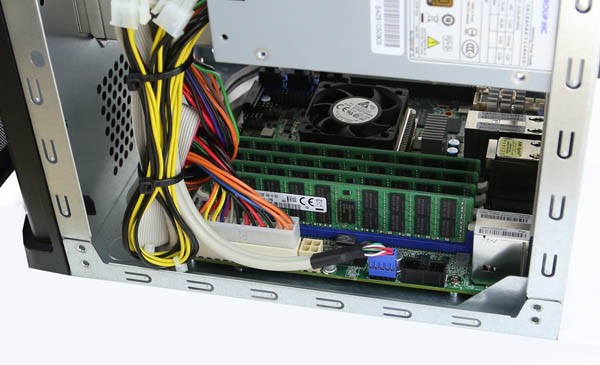
Installing RAM is very easy. Simply insert 1 to 4 DDR4 modules in the slots and you are ready to go.
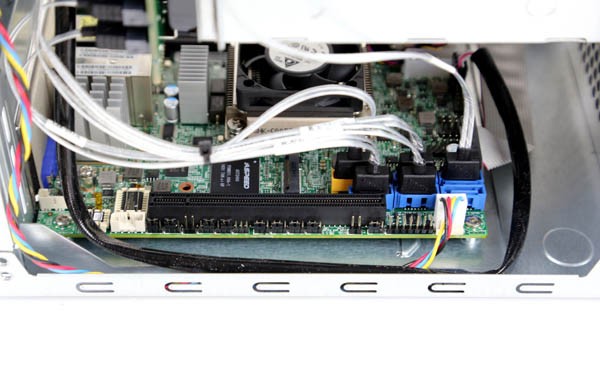
Internal expansion options on the motherboard include both a PCIe 3.0 x4 m.2 slot and a PCIe 3.0 x16 slot. One can easily add a 16-port external SAS controller, a PCIe NVMe AIC, and/ or a PCIe/ NVMe m.2 SSD. We have tested configurations with the installed Samsung XP941 in the m.2 slot and have used Intel DC P3600 and DC P3700 series as well as Fusion-io ioDrive SSDs in the PCIe 3.0 x16 slot. In theory, one could use a low power single-slot GPU and build a workstation out of this platform as well.
Moving to the rear of the chassis one can see that there are a lot of network ports. There is a single RJ-45 port for the IPMI remote management NIC. There are two NICs utilizing an Intel i350-am2 controller. The other two NICs are 10Gbase-T Ethernet ports that utilize the Intel Xeon D-1540 SoC onboard controller. As the STH Fremont colocation rack is now using 10Gbase-T, the addition of this controller takes a ~14w and $400 component and integrates it onto the motherboard.
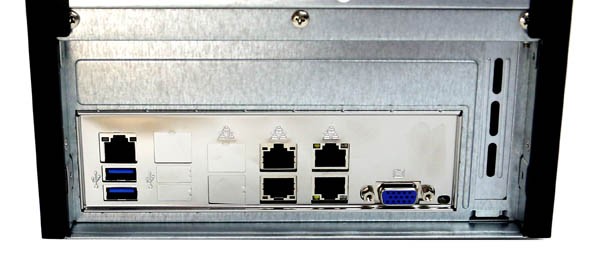
Overall, this little package has basically everything one could want from a small server.
Power Consumption
We used our standard Extech TrueRMS power meter along with our Tripp Lite PDU at the datacenter to monitor power consumption. Our configuration did have spinning disks which used (relatively) a lot of power along with five SSDs.
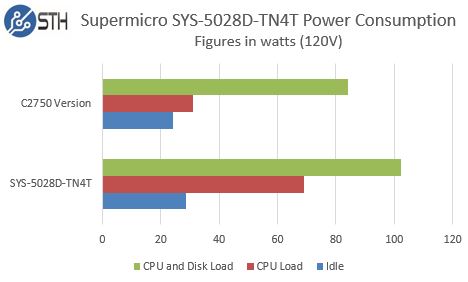
In terms of a system with five SSDs and dual 4TB hard disks, this is absolutely phenomenal. While it is about twice the power consumption we see of an Intel Atom C2750 system, one gets 3x as many SATA III ports, an additional PCIe 3.0 m.2 port, PCIe 3.0 x16 slot and 5.5x as much network bandwidth, 3x the processor performance (or more in many cases) and 4x the RAM capacity.
Sound
The Supermicro SYS-5028D-TN4T is a mini tower chassis which works well in an office setting that does not have an equipment rack. Noise in these types of environments is a primary concern.
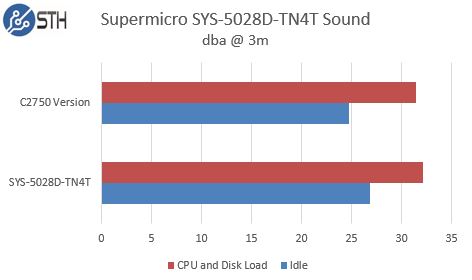
Overall, this was a great result. Perhaps more interesting is that we did not hear an annoying hum and the loudest part of the entire setup were the Western Digital Red NAS hard drives. We have recently been working with a Silicon Valley start-up looking for a 10x Node.js development cluster for their office, and they plan to use this solution after hearing our sample.
Remote Management
Supermicro’s IPMI and KVM-over-IP as described a few times on this site, allows for a lot of deployment flexibility. Things such as fan speeds, chassis intrusion sensors, thermal sensors, and etc. can be monitored remotely. Alerts can be setup to notify the admins of issues. Beyond this, the functionality also allows for remote power control. One can do remote power up, power down, and reset of the server in the event that it becomes unresponsive.
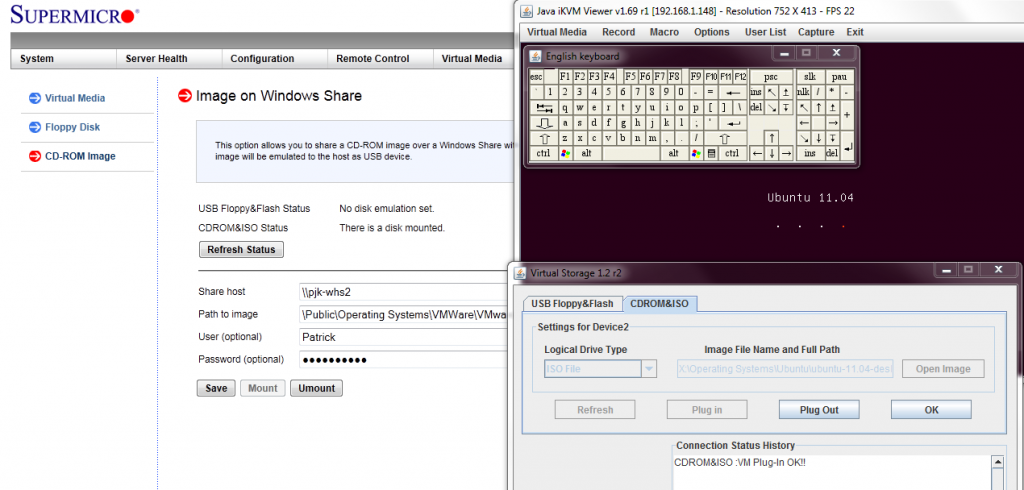
Another important feature is the ability to remotely mount CD images and floppy images to the machine over the dedicated management Ethernet controller. This keeps maintenance traffic off of the primary Intel NICs. At the same time it removes the need for an optical disk to be connected to the Supermicro motherboard.
The latest revision of Supermicro’s BIOS has a great feature: the BMC IP address shows up on the post screen! This is a super feature because if one has a KVM cart hooked up to the system, it gives an indicator of which machine one is connected to during post.

Supermicro does include KVM-over-IP functionality with the motherboard. We have been testing servers from HP, Dell, Lenovo and Intel that all required an additional add-in key to get this functionality. It is an absolute time and money saver in the datacenter and other vendors should follow Supermicro’s lead in this space.
Conclusion
Overall, the Supermicro SYS-5028D-TN4T packs a lot of power in a diminutive platform. The barebones is extremely easy to configure since one can have a functional system by screwing in a few hard drives and slotting RAM. Once the system is setup, one has the horsepower of a legacy dual socket system in a size, power and noise envelope that is perfect for in-office clusters that reside under a desk or in a closet. We did have several users in the STH forums already start to use these Supermicro SYS-5028D-TN4T systems in low cost colocation facilities designed for mini towers. In fact, we even installed this test unit in our Fremont, California rack shelf next to our management Intel NUC node and it has been running flawlessly for two weeks thus far.
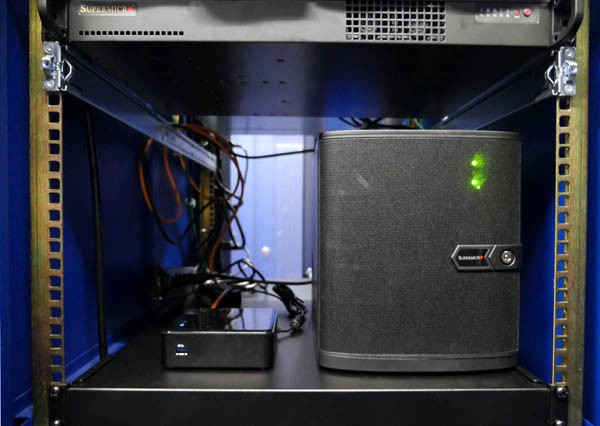

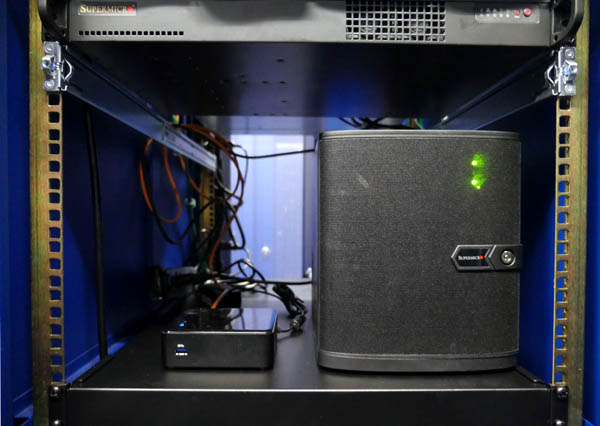



I am much like this server. I cannot buy yet in my country but I want to.
I don’t know why Supermicro doesn’t make a version of the Xeon D-1520($199) with DDR3L dimm slots. You could cut at least 800 dollars off the total cost of the system, and it is still powerful enough for a zfs server.
No kidding, wish the had it as an option for a small home zfs server.
Hey Patrick,
From what I see there is only one exhaust fan (in the rear) in this chassis correct? However there is a vent in the lower front of the case. Is the chassis setup for you to install an additional intake fan there?
this reminds me of my broken HP N40L microserver of size dimension.
Looking great will recommend this to our DC.
Great review (and site). I’m guessing the SM951 AHCI is supported since its the correct size etc but will it support the new SM951 NVMe when available? Also please, is the SM951 a good fit for a server? Thanks.
Thank you Mark. I have not gotten to test it with the Samsung NVMe m.2 drive yet. The PCIe slot has no issues with Intel NVMe drives (750, P3600, P3700) so I would suspect the x4 m.2 slot would work fine.
Thanks Patrick much appreciated.
Hey Patrick!
do you know a supported RAID-Controller with BBU for this Server?
Thanks!
I think it would be best to check the HCL for an officially supported controller, but the PCIe slot has been accepting of most cards I have tried.
I am interested in this as a HYPER-V host machine but I need to be able to install a graphics card that will support RemoteFX. Are there any you can recommend or that you know will work? A minimum of two GB VRAM memory is needed and given the power supply I know that it must be low power. Did you try using any graphics cards in the server? Thanks!
If you still have this machine, could you comment on the temperature the drives run at (and for comparison, the drive model as well)? I have an In Win chassis which seems to keep the drives running way too hot, and was considering replacing it with this chassis if the drives were kept at a reasonable temperature